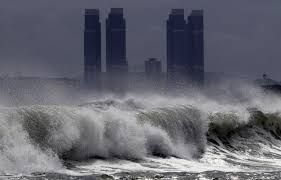Flood mitigation is essential. Yet though Japan and South Korea have few climate-change deniers, the sense that warming is a problem generated elsewhere has persisted for too long, says Ohbayashi Mika of the Renewable Energy Institute in Tokyo. That is changing faster in South Korea. Its civil society is more vigorous than Japan’s— and in a recent Gallup poll seven out of ten Koreans said recent floods underlined the seriousness of climate change. President Moon Jae-in promises to close ten coal plants before the end of his term in 2022. This week he used the typhoons as a reason to push for a trebling of renewable generation by 2025. South Korea’s coronavirus-related spending packages have had a strongly green element, says Ms Ohbayashi, unlike Japan’s.
防洪減災(zāi)至關(guān)重要。盡管日本和韓國(guó)很少否認(rèn)氣候變化,但是民眾已經(jīng)察覺到了氣候變暖是萬惡之源,而且這種感覺已經(jīng)持續(xù)了很久,東京可再生能源研究所表示。這種情況在韓國(guó)的轉(zhuǎn)變更快。韓國(guó)民間社會(huì)比日本更加活躍,在最近的一次蓋勒普民意調(diào)查中,有十分之七的韓國(guó)人表示,最近的洪水災(zāi)害已經(jīng)凸顯了氣候變化的重要性。總統(tǒng)文在寅承諾在2022年任期結(jié)束前關(guān)閉十座煤電廠。本周,他以臺(tái)風(fēng)為由,強(qiáng)烈要求到2025年,可再生能源開發(fā)量增加兩倍。與日本不同的是,韓國(guó)推行的與冠狀病毒相關(guān)的支出計(jì)劃中包含強(qiáng)烈的綠元素。

There, media coverage of weather events makes the link to climate change. Yet Japan’s own hefty carbon emissions rarely come up, says Watanabe Eri of 350.org, a green pressure group. Coal’s share in power generation has risen in the past decade, especially after Japan shut its nuclear plants. Targets adopted under the outgoing prime minister, Abe Shinzo, are feeble: coal will still be more than a quarter of the mix by 2030. Japan also promotes coal plants abroad.
韓國(guó)媒體進(jìn)行氣候事件的報(bào)道時(shí),會(huì)涉及氣候變化。然而,綠色壓力集團(tuán)350.org的渡邊埃里表示,日本媒體很少報(bào)道日本的巨額碳排放量。過去十年,發(fā)電量中的煤炭比重有所上升,特別是在日本關(guān)閉核電站之后。即將卸任的日本首相安倍晉三采納的相關(guān)目標(biāo)有些牽強(qiáng),即到2030年,煤炭仍將占發(fā)電量的四分之一以上。日本還在海外推廣煤電廠。
Change is always possible. Japanese businesses are under pressure from Western partners to cut their carbon use. Three years of floods have boosted new volunteers at Ms Watanabe’s group fivefold. The numbers remain tiny—around 250 a year. But all typhoons start with the merest waft of air.
改變總是可能實(shí)現(xiàn)的。日本企業(yè)正面臨著來自西方伙伴的壓力,要求他們削減碳排放。三年的洪災(zāi)使渡邊女士所在組織的志愿者人數(shù)新增了五倍。但是人數(shù)還是很少,每年只有250人左右。但是最輕微的氣流也終會(huì)卷起臺(tái)風(fēng)。
譯文由可可原創(chuàng),僅供學(xué)習(xí)交流使用,未經(jīng)許可請(qǐng)勿轉(zhuǎn)載。











